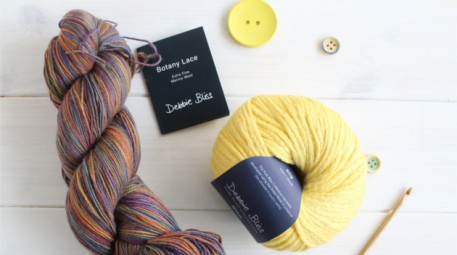When choosing yarn for a new project, it's important to take fiber into consideration. But in the end, what's the difference between wool and alpaca, and why does it matter?
Many of us have knitted the same pattern a friend made, only to discover that ours looks completely different. Maybe it doesn't have enough drape, the texture seems tight, or it never seems to return to the right shape even after blocking. So what's the deal?
Every fiber has different characteristics that make it better for some projects and more challenging for others. This means that when choosing yarns for a pattern, especially when substituting yarn, you need to take the fiber content into consideration. We created a helpful list of some of the most popular natural fibers and what makes them great. If you want to learn more about the importance of natural fibers to the ecosystem, click here.
Alpaca
Alpaca is sometime's called "the poor man's cashmere" due to its affordability and super soft fiber. It's become a very popular fiber to knit and crochet with in recent years, and people can't get enough of it!
Alpacas are very cute, and can be raised in a variety of environments. Known for being gentle beasts, their fiber can be separated into different categories according to softness. Even adult alpacas can produce "baby alpaca" fiber, they just grow less of it than the little ones do.
Want to try out some alpaca yarn? We love Rooster Almerino Aran for a bargain option, and Amano Mamacha for a super soft luxury.
Wool
Wool has been around for eons, ever since humans learned how to cultivate crops and herd animals. Sheep are usually gentle animals, and modern domesticated breeds have to be shorn every year to protect them against flystrike and wool overgrowth which can lead to damaging skin conditions.
There are many different breeds of sheep that produce very different kinds of fiber, from merino sheep which produce a super soft wool, to other breeds which yield more rustic, hard wearing fleece.
We love Debbie Bliss Falkland Aran for a British breed yarn.
Cashmere
Fiber from goats? Of course! Like sheep, different breeds of goats can produce vastly different kinds of fiber. Certain breeds can also produce mohair fiber!
Cashmere is the standard for luxury fiber; whether factory made or hand-knitted, cashmere sweaters are among the softest and most luxurious you'll ever wear. Many yarns are blended with cashmere for softness, providing a stronger staple fiber that means it can be more easily washed.
We're in love with Rowan Cashmere for a pure cashmere, and Debbie Bliss Cashmerino for a machine washable blend.
Cotton

Above: two cotton blend Rowan yarns
Most of the clothing we wear is made of cotton: jeans, t-shirts, socks, and undergarments are all made of cotton. Grown in warmer climates, cotton grows in a prickly pod which must be extracted, combed, and prepared for spinning into thread or yarn.
There are two main kinds of cotton yarns: mercerized and natural. Mercerized cottons have a subtle shine to them, a tighter spin, and can have more vibrant shades in their palette. Yarns that are mercerized go through a heat treatment process that makes the fiber more susceptible to dyes and more rope like in texture.These yarns are popular with crocheters because they do not split when you use them, and are relatively hard-wearing.
Natural cotton yarns have not been heat treated, and are generally softer and with longer staple fibers than their mercerized cousins. Natural cottons are popular choices for dishcloths for their washability.
Check out Cascade Ultra Pima for a pure cotton in a rainbow of shades!
Bamboo
Above: Louisa Harding Pittura bamboo blend yarn
Contrary to popular belief, bamboo yarns are not made with the stalks of bamboo itself. While some cultures around the world have created clothing and accessories with bamboo stalks, to create yarn the bamboo is pulped into a viscose which can be spun into yarn.
Bamboo has a lovely drape thanks to it's plant cell structure, and many bamboo yarns share a subtle shine that's perfect for shawls and other accessories. That lovely drape also means that bamboo can struggle to return to its original shape: as such a bamboo blend should be used for garment knitting. Bamboo can be grown on fallow land that can no longer support crops, and so many bamboo yarns are continuously sustainably sourced with no harm to the environment.
We love Lotus Bamboo Soft for a pure bamboo, and Louisa Harding Pittura for a scrummy bamboo blend!
Love this post? Pin this image!

What fiber is your favorite to knit or crochet with?







